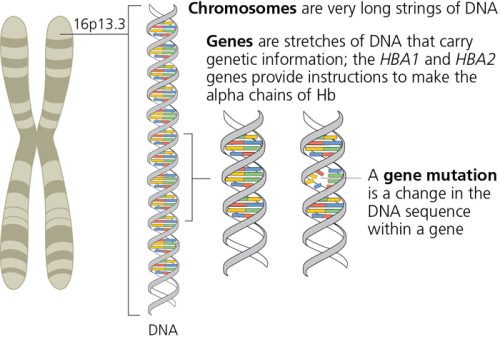This is the second part of our series about the condition based on our patient booklet “Fast Facts for Patients: Alpha Thalassemia”. This article explains genes and genetic inheritance as well as one gene change in alpha thalassemia (AT).
Genes and Genetic Inheritance
Genes are carried on chromosomes. Every cell in our bodies has 23 pairs of chromosomes – so 46 in total. Every chromosome carries anywhere from 55 to 20 000 genes.
Genes are in pairs too. You inherit one copy from your mother and one copy from your father. A pair of genes is carried on a pair of chromosomes (one gene on each chromosome). Each pair of genes carries the code to make a single protein. Proteins are chains of chemical building blocks called amino acids and they are vital for the body to function.
Altogether, your genes carry the blueprint for the growth, development and function of your entire body.

Which Genes Are Involved?
Production of the Hb alpha chains is controlled by two pairs of genes – HBA1 and HBA2. The codes they carry are the same.
Each person inherits one copy of each gene from their father and another copy of each gene from their mother. This means that there are four gene copies that can potentially cause AT:
- Two HBA1 genes
- Two HBA2 genes.

Deletional and Non-Deletional Gene Changes
There are two important types of gene change in AT.
- If a gene is completely missing, it is called deletional thalassemia.
- If a gene is not missing but is damaged, it is called non‑deletional thalassemia. Non-deletional gene changes tend to cause more severe symptoms than deletional ones.
Location of Gene Changes
If you have two gene changes, the missing or damaged genes can both be on the same chromosome. This is called a ‘cis’ mutation (gene change). You may see this written as aa/– in your notes.
Or there may be one gene change on each chromosome. This is called a ‘trans’ mutation. You may see this written as a-/a in your notes.

Why Is It Important to Know More about My Condition?
If you are pregnant or planning to become pregnant, it is important to understand more about your genetic condition. Understanding more means you are better informed about the risks to your unborn child.
It is important for parents to know if the gene changes are on the same chromosome or on different chromosomes.
Ask your doctor about your gene changes and write the information down.
One Gene Change
If you have only one AT gene change, you are said to be a silent carrier. This is also called AT minima.
What Does This Mean?
You won’t have any signs of AT and will have no health problems related to it.
If you are a carrier and you have a child with someone who is also a carrier, for each pregnancy there is a:
- 1 in 4 chance (25%) the baby will have AT trait (two gene changes)
- 1 in 2 chance (50%) the baby will be a silent carrier (one gene change)
- 1 in 4 chance (25%) the baby won’t have any gene changes.

Very rarely, and only with certain kinds of gene change, there is a chance of having a child with AT.
Please check out the other posts of our series here:
- What Is Alpha Thalassemia?
- Alpha Thalassemia: Two Gene Changes
- Alpha Thalassemia: Three Gene Changes
- Alpha Thalassemia: Four Gene Changes
- Alpha Thalassemia: Screening and Diagnosis
- Alpha Thalassemia: Symptoms and Treatment
- Alpha Thalassemia: Clinical Trials and New Treatments
- Living with Alpha Thalassemia
Information based on Fast Facts for Patients: Alpha Thalassemia (Karger, 2023).





Comments
Share your opinion with us and leave a comment below!